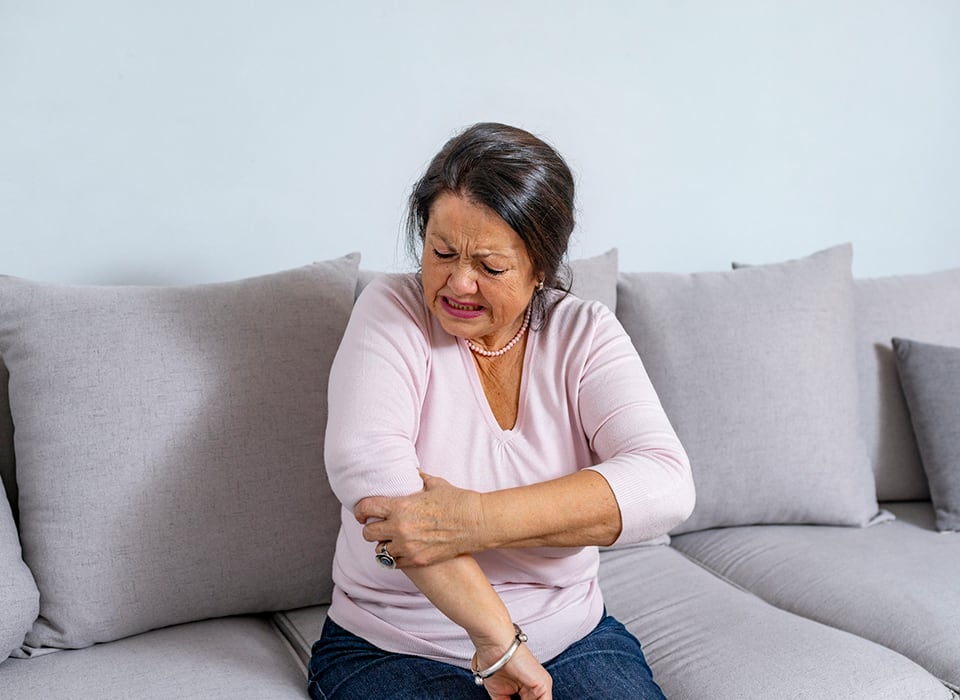Key Points
- Arthritis is damage to the joints that results in changes to the joint lining, cartilage, ligaments and bones.
- The goal of arthritis treatment is to decrease pain and improve function.
- Exercise is an important aspect of treatment.
- There is no current way to reverse damage. All treatment is to slow progression and to minimize symptoms.
Intro
Arthritis is a common problem, affecting 91 million Americans. 31 million Americans, or about 1/3 of people with arthritis, have osteoarthritis. Osteoarthritis is the breakdown of the cartilage (the tissue that cushions the ends of the bones between joints), bony changes of the joints, deterioration of tendons and ligaments, and various degrees of inflammation of the joint lining (called the synovium). Arthritis can occur in all the joints of the body but is commonly seen in the spine, shoulders, hips, knees, hands and feet.
Osteoarthritis is the most common form of arthritis. It mainly effects middle age and elderly patients but can occur at all ages. Osteoarthritis is the most common cause of disability in the elderly. The average risk of developing arthritis is between 40-50%.
Cartilage is tissue that goes between bones in a joint and acts as a shock absorber. As the cartilage breaks down, the joint experiences more stress and strain; as a result, the bone gets bigger (also called osteophytes) to decrease the pain from the increased stresses seen at the joint. The goal of treatment is to decrease pain and improve function. At the moment, there is no cure for arthritis but some treatments are aimed to try and slow the progression and help manage symptoms.
Common symptoms:
- Joint pain and stiffness
- Swelling and bony prominences (results of the osteophytes)
- Cracking and grinding with movement of the joints
- Decreased range of motion or function
Causes
Osteoarthritis is caused by several different things including abnormal anatomy, abnormal biology, overuse and genetics. There are two categories of risk factors for osteoarthritis: modifiable and non-modifiable. Risk factors you can do something about include injuries, repetitive stress/overuse, obesity, and muscle weakness. Risk factors you have no control over are ones such as old age, gender (women are more likely than men to get osteoarthritis), genetics (having family members with osteoarthritis) and inherited joint issues like scoliosis, hip dysplasia, bowlegs or knocked knees.
Diagnosis
The diagnosis of osteoarthritis is made from a combination of history, physical exam, and imaging. A doctor will ask you to provide information about what type of pain you have, how long you have had it, when it started, where it is, what things make it better and worse, etc. The doctor will examine your areas of complaint. The doctor may also have you go for x-rays or other imaging.
The symptoms that commonly go along with arthritis:
- joint pain that is keeping you from doing things
- pain at night or while resting
- swelling after moving around
- joint stiffness
- instability or feeling like the joint is locking or catching
During the physical exam, the doctor is looking for:
- decreased range of motion or not being able to move your joint as much as people without arthritis can
- pain, especially while moving
- swelling of joints
- legs with different lengths, arms and legs not in normal positions, or spine not in a usual position
After the x-ray or other imaging, the doctor is looking for:
- narrower spaces than usual in your joint
- extra bone growing out from the edge of joints, called osteophytes
- extra hardening within the bone, called sclerosis
- subchondral cysts (areas filled with fluid) that result from joint fluid at the edges of the joint
- loss of normal anatomy with the bones wearing away from increased stress and underlying deformity.
Treatment
There are many different treatment options for arthritis. Your doctor will let you know which ones would be best for you.
Non-Surgical Treatments
Non-surgical treatments are the most common types and are the first treatments doctors will give to help people with arthritis.
- Patient education: learning more about arthritis, the specific effects arthritis is having on you, and your specific options.
- Activity modification: Changing how you move or what kinds of activities you do to reduce the stress on your joints while keeping you active.
- Exercise/periarticular strengthening: Doing exercises to improve your muscle strength, decrease joint pain and stiffness, and lower the chance of disability due to osteoarthritis.
- Weight loss: Your back, hips, and knees see anywhere from 3-6 times your body weight when you move, so losing weight will decrease the stress on your joints.
- Assistance devices: Using orthotics, braces, canes, walking sticks, walkers, or wheelchairs as appropriate.
- Heat or cold therapy: Using heat packs or ice packs as told to by your doctor can help relieve swelling and pain.
- Medications: Non-Steroidal Anti-Inflammatory Drugs (NSAID) medications are the gold standard for treatment. Topical versions are available if you have trouble taking pills.
- Steroid intraarticular injections: Steroid injections into the joint decrease inflammation and the secondary pain and stiffness.
Surgical
If the non-surgical treatments don’t work, surgical treatments are the next step. There are three main types.
- Joint offloading procedures: changing where bodyweight and stress are put on a joint so the arthritic part of a joint is not getting damaged more. (i.e. periarticular osteotomies)
- Joint fusions: connecting the bones in a joint together so they cannot move and rub against each other.
- Joint replacements: putting material between the parts of the joint that have arthritis, replacing part of the joint, or replacing all of the joint.
Next Steps
If you are concerned that you have arthritis and have joint or spine pain you should see a doctor. Contact your primary care physician or call the OrthoVirginia office closest to you to schedule an appointment.

